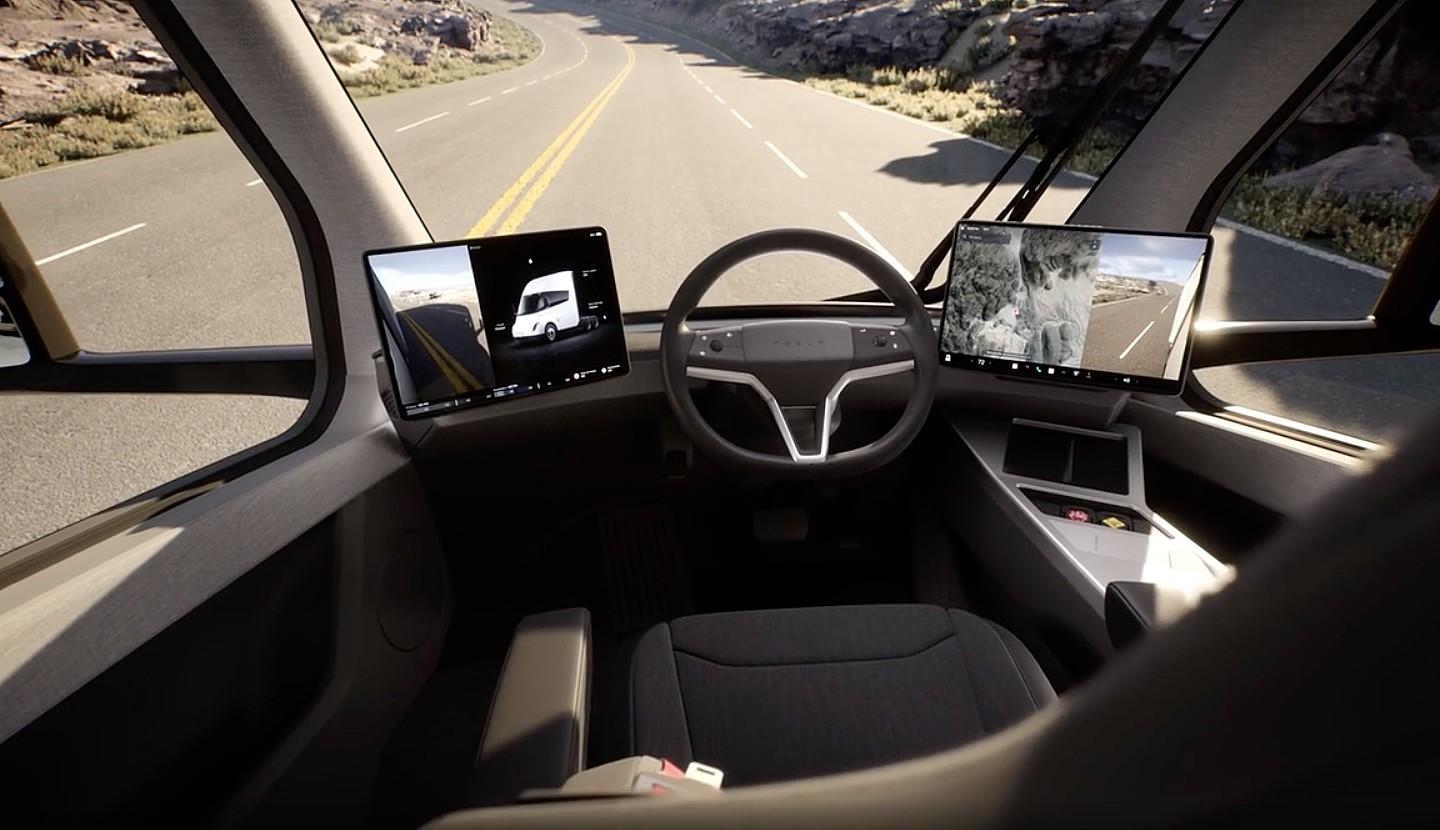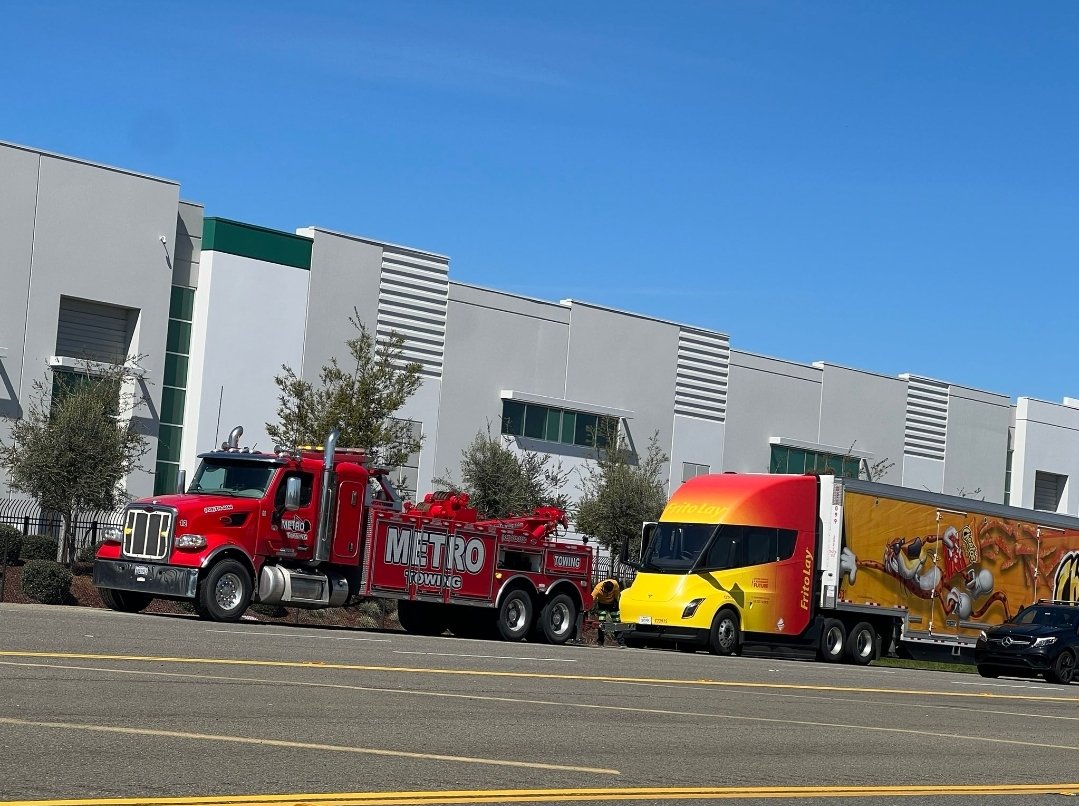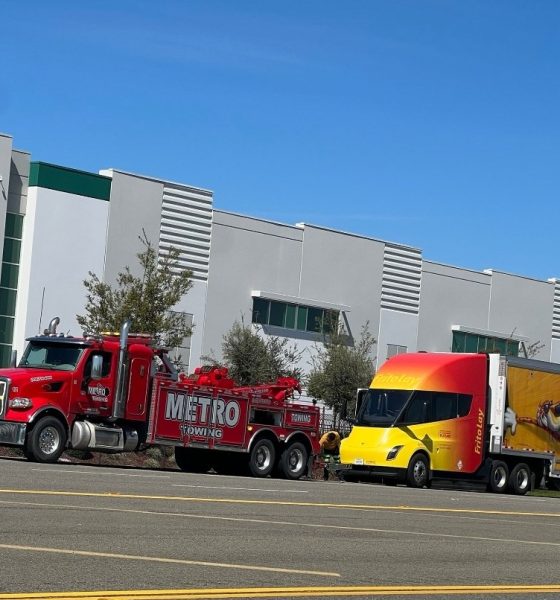Since Tesla delivered the first units of its all-electric Semi to Frito-Lay facilities in Modesto, California, in December 2022, any instance of one breaking down on the side of the road has been photographed and highly publicized. However, Teslarati has been told that at least some of the “breakdowns” are caused by a glitch within a software switch, and drivers are pulling over voluntarily as a precaution because the dash screens will flicker and sometimes shut off.
Since December, there have been at least eight instances of Tesla Semi vehicles breaking down. Some attributed it to a loss of range from carrying a load of products, as weight and hauling affect how far an EV can go.
Others suspected it was a mechanical issue, as the Semi is still a relatively young product that has been in development for some time but has only been used in real-world applications by a company that is not Tesla for a few months.
Tesla Semi developers reflect on first deliveries: ‘Out the door. For the world.’
While these are a possibility, they would be expected. Vehicles break down all the time for various reasons, including mechanical failures, and people often run out of gas in combustion engine vehicles and/or range in EVs.
Tesla Semi drivers are experiencing dash issues
At least some of the Semi breakdowns can be attributed to a glitch with a software switch, Teslarati has learned. How many of the breakdowns can be attributed to this issue is unknown, but more than one has been described as having this problem.
According to a source close to the operation in Modesto, drivers are pulling over their Semis as a precaution, as the glitch is causing the dash screens and lights on those screens to flicker and sometimes shut off. “They don’t know what to do,” said the person who did not want to be identified. “So they just pull over, and then they are towed.”
Drivers and others involved in the logistics portion of the operation at Frito-Lay that use the Tesla Semi have stated that the screens will not operate properly. Drivers are pulling over as the screens hold valuable information, such as speed, range, camera views surrounding the truck, suspension information, trailer hitch controls, and more.
Tesla Semi interior (Credit: Tesla)
Without the screens being operational, drivers run into issues that can affect how their jobs are performed, including important safety metrics like speed.
The vehicles are then towed to what we were told is a “secret location” in Lathrop, California, for inspection and repair.
A tow truck driver that has been responsible for transporting the Semis to Lathrop said they had towed at least four units to that location thus far.
Why This Isn’t So Bad
The Semi has only been in Frito-Lay’s hands for about four months, and it is an extremely early project that is still a very limited operation. Frito-Lay expects to have only fifteen Tesla Semis in Modesto this year, so the vehicle is not taking over the entire fleet. In fact, Frito-Lay has adopted various sustainable technologies from several companies to make the Modesto plant more environmentally friendly.
The issues, if completely software-related, can be fixed by Tesla engineers. While the Semi is much different than its passenger vehicles, Tesla has a reputation for having some of the best software in the EV industry. There would likely be much more concern if these breakdowns could be attributed to a part failure or range depletion.
Tesla already displayed the Semi’s capabilities with a full load during the unveiling event in December, showing the all-electric class 8 truck traveling 500 miles on a single charge. We were not told about or made aware of any hardware failures or breakdowns that were caused by parts failures.
Tesla Semi completes 500-mile journey weighing in at 81,000 pounds
The problems with the Semi are likely expected by both Tesla and Frito-Lay as it is still an early-stage vehicle that is being rolled out in a very limited fashion.
Frito-Lay/PepsiCo. did not immediately respond to our request for comment.
What’s Next
Tesla is still moving forward with its plans to expand Semi production in Nevada, as earlier this year, it announced it would build a $3.5 billion expansion to Giga Nevada.
As for Frito-Lay and PepsiCo’s facility in Modesto, there is no indication that they will let a few early issues with the Semi ruin their fleet. In fact, the facility is set to have Megachargers installed at its plant in Fresno, California.
As far as we know, the Semi is still operating daily. Yesterday, it was spotted in Sacramento.
The big picture is that vehicles break down, and new vehicles sometimes have issues that need to be ironed out. It doesn’t mean the project is a failure or that the Semi is doomed to be a dud. It’s the growing pains of the Semi operation.
Disclosure: Joey Klender is a TSLA Shareholder.
I’d love to hear from you! If you have any comments, concerns, or questions, please email me at joey@teslarati.com. You can also reach me on Twitter @KlenderJoey, or if you have news tips, you can email us at tips@teslarati.com.

News
Elon Musk’s Grokipedia surges to 5.6M articles, almost 79% of English Wikipedia
The explosive growth marks a major milestone for the AI-powered online encyclopedia, which was launched by Elon Musk’s xAI just months ago.

Elon Musk’s Grokipedia has grown to an impressive 5,615,201 articles as of today, closing in on 79% of the English Wikipedia’s current total of 7,119,376 articles.
The explosive growth marks a major milestone for the AI-powered online encyclopedia, which was launched by Elon Musk’s xAI just months ago. Needless to say, it would only be a matter of time before Grokipedia exceeds English Wikipedia in sheer volume.
Grokipedia’s rapid growth
xAI’s vision for Grokipedia emphasizes neutrality, while Grok’s reasoning capabilities allow for fast drafting and fact-checking. When Elon Musk announced the initiative in late September 2025, he noted that Grokipedia would be an improvement to Wikipedia because it would be designed to avoid bias.
At the time, Musk noted that Grokipedia “is a necessary step towards the xAI goal of understanding the Universe.”
Grokipedia was launched in late October, and while xAI was careful to list it only as Version 0.1 at the time, the online encyclopedia immediately earned praise. Wikipedia co-founder Larry Sanger highlighted the project’s innovative approach, noting how it leverages AI to fill knowledge gaps and enable rapid updates. Netizens also observed how Grokipedia tends to present articles in a more objective manner compared to Wikipedia, which is edited by humans.
Elon Musk’s ambitious plans
With 5,615,201 total articles, Grokipedia has now grown to almost 79% of English Wikipedia’s article base. This is incredibly quick, though Grokipedia remains text-only for now. xAI, for its part, has now updated the online encyclopedia’s iteration to v0.2.
Elon Musk has shared bold ideas for Grokipedia, including sending a record of the entire knowledge base to space as part of xAI’s mission to preserve and expand human understanding. At some point, Musk stated that Grokipedia will be renamed to Encyclopedia Galactica, and it will be sent to the cosmos.
“When Grokipedia is good enough (long way to go), we will change the name to Encyclopedia Galactica. It will be an open source distillation of all knowledge, including audio, images and video. Join xAI to help build the sci-fi version of the Library of Alexandria!” Musk wrote, adding in a later post that “Copies will be etched in stone and sent to the Moon, Mars and beyond. This time, it will not be lost.”
News
Tesla Model 3 becomes Netherlands’ best-selling used EV in 2025
More than one in ten second-hand electric cars sold in the country last year was a Tesla Model 3.

The Tesla Model 3 became the most popular used electric car in the Netherlands in 2025, cementing its dominance well beyond the country’s new-car market.
After years at the top of Dutch EV sales charts, the Model 3 now leads the country’s second-hand EV market by a wide margin, as record used-car purchases pushed electric vehicles further into the mainstream.
Model 3 takes a commanding lead
The Netherlands recorded more than 2.1 million used car sales last year, the highest level on record. Of those, roughly 4.8%, or about 102,000 vehicles, were electric. Within that growing segment, the Tesla Model 3 stood far ahead of its competitors.
In 2025 alone, 11,338 used Model 3s changed hands, giving the car an 11.1% share of the country’s entire used EV market. That means more than one in ten second-hand electric cars sold in the country last year was a Tesla Model 3, Auto Week Netherlands reported. The scale of its lead is striking: the gap between the Model 3 and the second-place finisher, the Volkswagen ID3, is more than 6,700 vehicles.
Rivals trail as residual values shape rankings
The Volkswagen ID.3 ranked a distant second, with 4,595 used units sold and a 4.5% market share. Close behind was the Audi e-tron, which placed third with 4,236 registrations. As noted by Auto Week Netherlands, relatively low residual values likely boosted the e-tron’s appeal in the used market, despite its higher original price.
Other strong performers included the Kia Niro, the Tesla Model Y, and the Hyundai Kona, highlighting continued demand for compact and midsize electric vehicles with proven range and reliability. No other model, however, came close to matching the Model 3’s scale or market presence.
News
Tesla Model Y Standard Long Range RWD launches in Europe
The update was announced by Tesla Europe & Middle East in a post on its official social media account on X.

Tesla has expanded the Model Y lineup in Europe with the introduction of the Standard Long Range RWD variant, which offers an impressive 657 km of WLTP range.
The update was announced by Tesla Europe & Middle East in a post on its official social media account on X.
Model Y Standard Long Range RWD Details
Tesla Europe & Middle East highlighted some of the Model Y Standard Long Range RWD’s most notable specs, from its 657 km of WLTP range to its 2,118 liters of cargo volume. More importantly, Tesla also noted that the newly released variant only consumes 12.7 kWh per 100 km, making it the most efficient Model Y to date.
The Model Y Standard provides a lower entry point for consumers who wish to enter the Tesla ecosystem at the lowest possible price. While the Model 3 Standard is still more affordable, some consumers might prefer the Model Y Standard due to its larger size and crossover form factor. The fact that the Model Y Standard is equipped with Tesla’s AI4 computer also makes it ready for FSD’s eventual rollout to the region.
Top Gear’s Model Y Standard review
Top Gear‘s recent review of the Tesla Model Y Standard highlighted some of the vehicle’s most notable features, such as its impressive real-world range, stellar infotainment system, and spacious interior. As per the publication, the Model Y Standard still retains a lot of what makes Tesla’s vehicles well-rounded, even if it’s been equipped with a simplified interior.
Top Gear compared the Model Y Standard to its rivals in the same segment. “The introduction of the Standard trim brings the Model Y in line with the entry price of most of its closest competition. In fact, it’s actually cheaper than a Peugeot e-3008 and costs £5k less than an entry-level Audi Q4 e-tron. It also makes the Ford Mustang Mach-E look a little short with its higher entry price and worse range,” the publication wrote.










